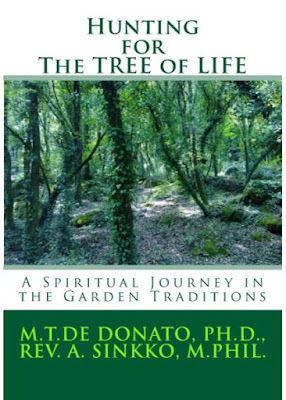Excerpt from the book Hunting for The
TREE of LIFE
(De Donato & Sinkko, 2016)
(pp. 23, 24)
(NOTE: I am aware that on some PCs the following text might appear as being written with all capital letters. I can assure my readers that the text it is not. I apologize for this inconvenience I tried to fix myself but have no control over. Thank you for your understanding.)
…. In the Garden of Eden the
harmony and strong bond which were the hallmark of the initial relationship
between God (you can call It/Him/Her Life, Universe, or however you please and
feel more comfortable with) and Humanity got lost. Both this account and the restoration of that
harmony, which took place in the garden of the Tomb, also called “the Place of
a Skull” or “Golgotha”, may be hiding, in our view, the turning point to the
discovery of what might be the most sought-after goal as for understanding the
reason and dynamics of Life and Death, hence of health and disease. Many of us have always been fascinated and
intrigued by the ‘Mystery of Life’ and often wondered why we are to grow old
and die rather than enjoy a healthy, harmonious, rich, gratifying, endless
existence on Earth. Since a very young age we hear that we – as Human Race –
are the most intelligent creatures on this planet; that over the millennia we
have ‘evolved’ to an extent not possible to any other species we know of; that
among us there have been many people who marked human history through amazing
discoveries, fundamental and deeper comprehension of so many aspects of life
which highly contributed to the greatest progress in many fields. And yet, except for a tiny minority of people
who lived more than 100 years, the vast majority lives barely an average of
70-80 years and this if and when everything goes well. On the other hand, we – the most intelligent
and ‘civilized’ species – when it comes to lifespan end up being greatly surpassed
by creatures such as North Atlantic Ocean ,
which has been reported living up to 507 years;Greenland
sharks and the koi fish, which can reach and even pass 200 years; and May 23, 2016 from http://en.wikipedia.org/wiki/List_of_oldest_trees)
If to all of this we add that, we are made, at least according to our western
Judaic and Christian tradition, ‘in God’s image’ and end up living for such a
relatively short period of time the situation can be easily viewed as a paradox or even as total joke….
To know more about this topic and
to order copy of this book in either the paperback edition or kindle you can
click on
…. In the Garden of Eden the
harmony and strong bond which were the hallmark of the initial relationship
between God (you can call It/Him/Her Life, Universe, or however you please and
feel more comfortable with) and Humanity got lost. Both this account and the restoration of that
harmony, which took place in the garden of the Tomb, also called “the Place of
a Skull” or “Golgotha”, may be hiding, in our view, the turning point to the
discovery of what might be the most sought-after goal as for understanding the
reason and dynamics of Life and Death, hence of health and disease. Many of us have always been fascinated and
intrigued by the ‘Mystery of Life’ and often wondered why we are to grow old
and die rather than enjoy a healthy, harmonious, rich, gratifying, endless
existence on Earth. Since a very young age we hear that we – as Human Race –
are the most intelligent creatures on this planet; that over the millennia we
have ‘evolved’ to an extent not possible to any other species we know of; that
among us there have been many people who marked human history through amazing
discoveries, fundamental and deeper comprehension of so many aspects of life
which highly contributed to the greatest progress in many fields. And yet, except for a tiny minority of people
who lived more than 100 years, the vast majority lives barely an average of
70-80 years and this if and when everything goes well. On the other hand, we – the most intelligent
and ‘civilized’ species – when it comes to lifespan end up being greatly surpassed
by creatures such as
a) the ocean quahong (also called
Arctica islandica), a clam native to the North Atlantic Ocean ,
which has been reported living up to 507 years;
b) the Galápagos giant tortoise (Chelonoidis
nigra), which even when raised in captivity, can live more than 100 years with
the case of one that reached over 170 years;
c) the Greenland
sharks and the koi fish, which can reach and even pass 200 years; and
d) the immortal jelly fish (turritopsis
dohrnìi), which is considered to be potentially biologically immortal thanks to
the transdifferentiation process, a lineage reprogramming, through which it can
revert the cell development process to the polyp stage.
Should that be not enough, we ‘superior’
race are shamefully surpassed even by trees.
As a matter of fact, we find the Great Basin bristlecone pine (Pinus
longaeva) from the Californian White Mountains in the United States being more
than 5,000 years old; the Patagonian cypress (Fitzroya cupressoides) from the
Cordillera pelada in Los Rios located within Alerce Costero National Park in
Chile, being more than 3,600 years old, followed by many others whose lifespan
runs from 1,270 to 5,000 years. (Retrieved May 23, 2016 from http://en.wikipedia.org/wiki/List_of_oldest_trees)
If to all of this we add that, we are made, at least according to our western
Judaic and Christian tradition, ‘in God’s image’ and end up living for such a
relatively short period of time the situation can be easily viewed as a paradox or even as total joke….
To know more about this topic and
to order copy of this book in either the paperback edition or kindle you can
click on


